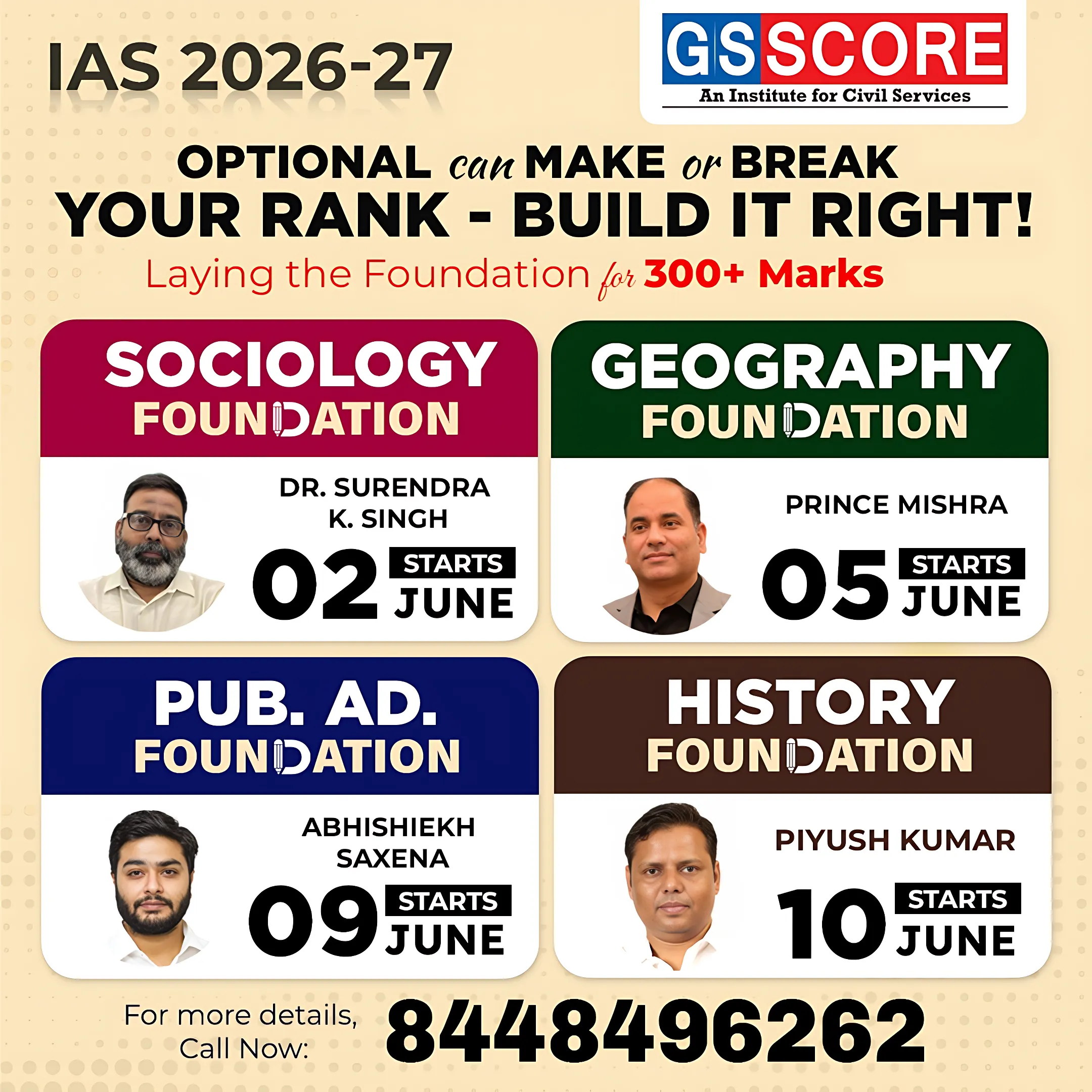

.jpg)
Instruction:
- Attempt both questions
- The test carries 30 marks.
- Write Each answer in 150 words.
- Any page left blank in the answer-book must be crossed out clearly.
- Evaluated Copy will be re-uploaded on the same thread after 2 days of uploading the copy.
- Discussion of the question and one to one answer improvement session of evaluated copies will be conducted through Google Meet with concerned faculty. You will be informed via mail or SMS for the discussion.
Question #1. How do recent archaeological findings and sangam literary text enlighten us about the early state and society in South India?
Question #2. Discuss the origin of Vijaynagar kingdom. Do you agree with the view that Krishnadevaraya was an ideal ruler of this dynasty?
(Examiner will pay special attention to the candidate's grasp of his/her material, its relevance to the subject chosen, and to his/ her ability to think constructively and to present his/her ideas concisely, logically and effectively).
STEPS & INSTRUCTIONS for uploading the answers
Step 1 - The Question for the day is provided below these instructions. It will be available at 7:00 AM.
Step 2 - Uploading of Answers : Write the answer in A4 Sheet leaving proper margins for comments and feedback and upload the PDF in MY ACCOUNT section. Click on the option of SUBMIT COPY to upload the PDF.
Step 3 - Deadline for Uploading Answers: The students shall upload their answers by 7:00 PM in the evening same day. The first 50 copies will be evaluated.
Step 4 - Feedback : Mentors will give their feedback for the answers uploaded. For more personalised feedback, join our telegram channel by clicking on the link https://t.me/mains_answer_writing_cse . A one-to-one session will be conducted with the faculty after copy evaluation in 72 Hrs.
Model Answer
Question #1. How do recent archaeological findings and sangam literary text enlighten us about the early state and society in South India?
The historiography of the early state and society in South India is primarily depicted by the rich Sangam texts. However, recent archaeological findings continue to explore the new dimensions of the early state of South India.
The Sangam literary texts give rich knowledge about the early state, according to which, the rudimentary society formation began with the three Sangam assemblies (all at Madurai).
This Sangam literature is written in a poetic form and provides elaborate information about three contemporary dynasties ie. Cholas, Cheras and Pandyas.
Sangam literature is broadly divided into two categories - Narrative texts (18) known as Melkanakku and Didactic texts (18) known as Kilkannaku. Melkanakku glorifies the warriors of the contemporary dynasties, which indicates the continuous conflict among them. Kilkannaku prescribes the social code of conduct to be followed in Tamil land. Sangam literature also highlights the flourishing economic activities and trade with the Roman Empire.
Apart from the Sangam literary texts, continuous excavations at various sites in the deep South like Adichanallur, Atirampakkam explain about the megalithic burial in the large amount present in South India. Various skeletons and other archaeological findings give an assessment about the early social life of the deep South. The Kaveri Delta marks the first area of settlement. It was the nucleus inhabited by the people.
A large number of dolmens and menhirs depict that the people believed in life after death too. It also gives an idea about their sources of livelihood and the tools found there depict that they were hunters and gatherers. It is also assumed that the South Indian people used iron first than North Indians.
Hence, the Sangam literary texts along with archeological findings help to explore the new social dimension of the society of South India.
Question #2. Discuss the origin of Vijaynagar kingdom. Do you agree with the view that Krishnadevaraya was an ideal ruler of this dynasty?
The origin of the Vijayanagara Kingdom dates back to the first half of the 14 century and is also seen as the beginning of the disintegration of Delhi Sultanate under Muhammad Bin Tughlaq.
The founders of the Vijayanagara Kingdom were Harihara and Bukka, who were the feudatories of the Kakatiya Kingdom. They were arrested by the Delhi Sultan and taken to Delhi and got converted to Islam. But in course of time, they again came back to South India and got converted back to Hinduism on the Mahanavami Festival under the guidance of an eminent priest.
They established the Vijayanagara Kingdom and started their dynasty. The future rulers were powerful and able to territorially expand and defeat the adjoining rulers of Hoysalas and Bahmani rulers.
The most progressive ruler under the Vijayanagara Empire was Krishnadevaraya who was the ruler of the Tuluva Dynasty. He reigned for around 20 years but is still considered as one of the most important rulers of South India.
The tag of an ideal ruler was given to him as he showed progressive character in all political, architectural, art, literature, external spheres etc.
On the political front, he was a powerful ruler and defeated the Bahama States and expanded his control till the West Coast. He maintained friendly relations with the Portuguese and with the modern artillery defeated the Gajapat ruler of Odisha and extended his rule from the Eastern Coast to the Western Coast.
On the cultural front, he was a great literary personality. He was the first person to write in the Telugu language and compiled the work Amuktamalayada about state administration. He also had great literary luminaries in his court like Allas Peddana as the Ashtadiggajas.
He also laid the innovative administration system in the form of the Nayankara System and Ayagar system that ensured the efficiency and control by the ruler.
In the field of architecture, he constructed several beautiful temples with new distinct features like Kalyana Mandapa, 1000 Pillars, large gopurams. The Virupaksha Temple at Hampi and Meenakshi Temple at Chidambaram are prime examples. He also constructed a new city, Nagalpura in the name of his mother that shows his respect towards women.
In this sense, Krishnadevaraya had all abilities of a strategist and had done indelible work in the history of Vijayanagara Kingdom and is considered as an ideal ruler of the Tuluva dynasty.
To participate in answer writing program, Register yourself for the test. Copies will be evaluated only for the registered students. Registration will be closed after the scheduled date.
48 Hrs. Answer Writing, Copy Evaluation and Marks Improvement Cycle
- Step 1 (Answer Writing): Questions will be uploaded on the portal on the scheduled date at 7:00 AM. You have to write your answers on an A4 size sheet leaving margins on both sides based on the UPSC pattern. Mention your name on the 1st page and page number on each page. After writing the answer, Click pictures of each page of your answer sheet, merge them all in a single PDF and upload in the comment section of the same question. Answers should be uploaded before 7:00 PM on the same day.
- Step 2 In Next 48 Hrs (Copy Evaluation & Discussion): After evaluation, the first 50 copies will be uploaded on the same comment box and will be sent to you. In the evening 8:00 PM marks improvement sessions for the test with respective faculty in a group will be conducted online. So that students can get a wider perspective of the topics. Here you can discuss your evaluated copies also with the faculty.


